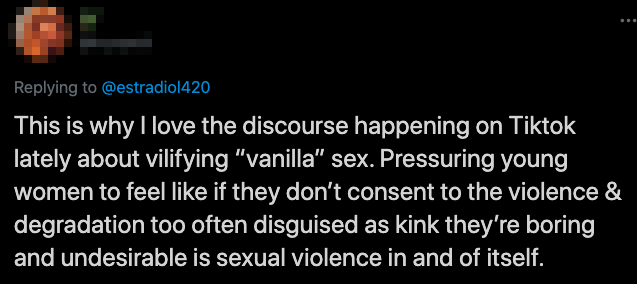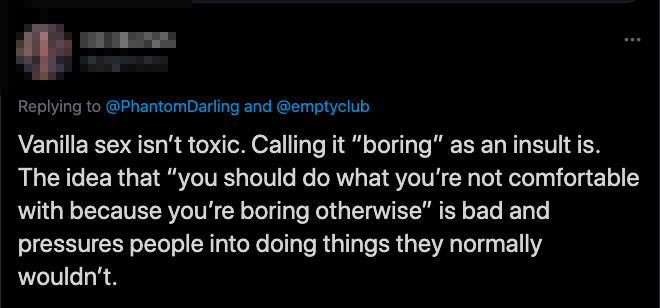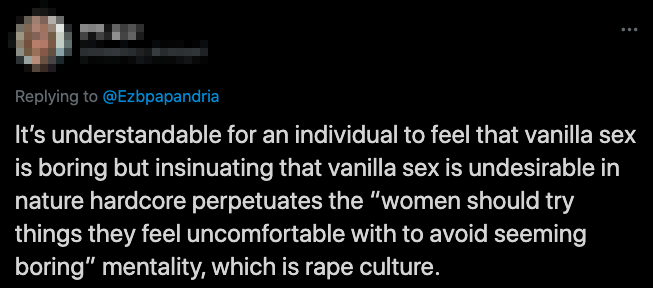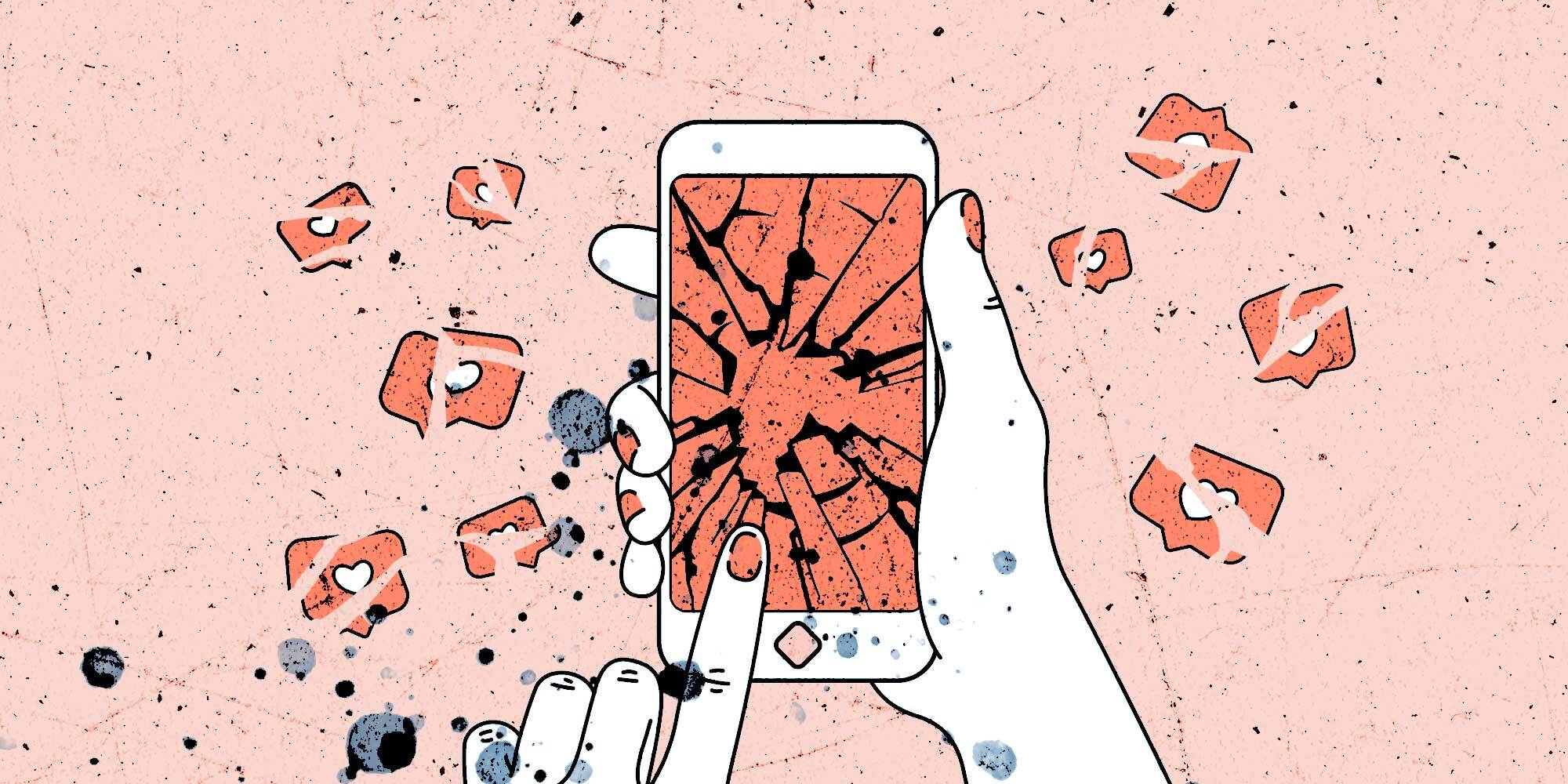Trigger warning: The following post contains descriptions of sexual violence and sex acts.
In an article published by The Independent, the author, Victoria Richards, recounts her experience of encountering sexual violence using a mainstream online dating site and being asked by a man whether she would be willing to accept “face slaps” and “drool” as a “reward.”
Tweeting about what she labeled as this “problematic” online experience, she received mixed feedback. Many women commented, sympathizing and elaborating on their similar experiences of receiving such proposals (including from men they’d only just met), asking if they would be up for riskier or more degrading sex acts. Others commented that Richards had been quick to judge the man, who was “simply being honest and upfront about his preferences”; some said she was in the wrong for calling him out and accused her of “kink-shaming.”
This story highlights an issue that’s become an increasingly discussed topic in recent years: the growth and acceptance of more extreme, “rough” sex into the mainstream culture.
“Harmless fun” or “normalized violence?”
References found in women’s health and beauty magazines promote the “spicing up” of women’s sex lives through more extreme sex acts.
In contrast, we see more vocal protests by organizations like We Can’t Consent to This, which raise awareness against the normalization and glamorization of extreme sex acts due to the rise in sexual violence, injury, and even deaths among women because of them.
On Tiktok, “vanilla sex,” or sex without any kinky, rough, or risky elements, has been so belittled and disparaged that some individuals have taken to Twitter to remind folks that it’s okay to enjoy “conventional” (or “vanilla”) sexual encounters.




So what’s the verdict?
This is not a black-and-white issue, and we’re certainly not here to control anyone’s sex life. Even so, there are implications to consider for the normalization of “rough sex,” especially as it’s displayed in porn, and this is especially true when examining adolescent sexual activity and teen dating trends.
Before writing off the normalization of “rougher” sex in the mainstream as nothing more than the integration of a “harmless” trend, let’s take a closer look at the facts.
“Rough” is in
While there has been a rise into the mainstream of sexual acts that were previously considered uncommon, many can even be physically risky, violent, and degrading, including “surprise” anal sex, strangulation (often labeled as “choking” or “breath-play”), spanking, BDSM-inspired sex games, etc.
It’s becoming common to see comments like the one below made around social media. Whether joking or not, it conveys the idea that a sexual encounter isn’t worthwhile unless it’s risky:

Especially concerning is that once “niche” violent sex practices are becoming what teens consider to be “normal” sex, with 13% of sexually active 14 to 17-year-olds reporting having been strangled during sex.
Research also shows an “increased prevalence” of some uncommon and higher health-risk sex acts, such as anal sex. Consider this: in 1992, a national survey found that only 16% of women between 18-24 had tried anal sex. In a 2016 National Health Statistics Report, this number rose to over 1 in 3 women, almost 36%.
These trends aren’t random
What is the driving force behind these trends?
It’s true the media plays a massive role. Movies and books like “Fifty Shades of Grey,” or songs that glorify aggressive sex are not rare in pop culture these days. Of course, pop culture has long been considered hypersexual, but now it’s more about violence than sheer sexuality. Consider the viral and sexually violent Netflix film “365 Days,” which was number one for a solid portion of summer 2020. This isn’t by chance. In fact, there’s another piece to the puzzle: the porn industry.
Even by the lowest estimate, research shows that more than 1 in every 3 porn videos depicts sexual violence or aggression.Fritz, N., Malic, V., Paul, B., & Zhou, Y. (2020). A Descriptive Analysis of the Types, Targets, and Relative Frequency of Aggression in Mainstream Pornography. Archives of sexual behavior, 49(8), 3041–3053. https://doi.org/10.1007/s10508-020-01773-0Copy In fact, according to a study that analyzed porn titles alone, 1 out of every 8 titles suggested to first-time users on porn sites described acts of sexual violence.Vera-Gray, F., McGlynn, C., Kureshi, I., & Butterby, K. (2021). Sexual violence as a sexual script in mainstream online pornography. The British Journal of Criminology, azab035. doi:10.1093/bjc/azab035Copy
How exactly does porn play into all this?
The porn industry increasingly capitalizes on content that deviates from what more tame, “conventional” sex entails. In porn, violent images aren’t a passive byproduct. They’re the goal.
While some studies have examined violence in porn by analyzing the content of porn videos, others have estimated the prevalence of violence in porn by asking porn consumers how frequently they see certain types of behaviors depicted in the porn they watch. For example, a recent Australian study found that 70% of young people reported frequently seeing men as dominant, 34% frequently saw women being called names or slurs, and 11% reported frequently seeing violence or aggression toward a woman that was nonconsensual. Another 13% of young people reported seeing aggressive nonconsensual sex “occasionally” when they watch porn, so together, the study found that 1 in 4 young people have had repeated exposure to depictions of violent, nonconsensual sex within the last year of their lives.Davis, A. C., Carrotte, E. R., Hellard, M. E., & Lim, M. (2018). What Behaviors Do Young Heterosexual Australians See in Pornography? A Cross-Sectional Study. Journal of sex research, 55(3), 310–319. https://doi.org/10.1080/00224499.2017.1417350Copy
While the amount of violence shown in porn is troubling, what is perhaps even more disturbing is the portrayed reactions to that violence. One study found that 95% of the targets of violence or aggression in porn appeared either neutral or appeared to respond with pleasure.Bridges, A. J., Wosnitzer, R., Scharrer, E., Sun, C. & Liberman, R. (2010). Aggression and Sexual Behavior in Best Selling Pornography Videos: A Content Analysis Update. Violence Against Women, 16(10), 1065–1085. doi:10.1177/1077801210382866Copy In other words, porn is sending the message that sexual violence is just a part of sexual pleasure.
Consider another study that entailed a large-scale content analysis and coding of a sample of 7,430 pornographic videos taken from the two most popular free porn sites, Pornhub and XVideos. The study found physical aggression against women present in 44.3% of Pornhub and 33.9% of Xvideos scenes. In fact, the study found that physical aggression was substantially more common in online pornographic videos than verbal aggression. Specifically, women were the target of nearly 97% of all physically aggressive acts in the samples from both sites. Violence in porn isn’t an exception.
Ideas shown in porn sometimes don’t stay on the screen. They make it into consumers’ bedrooms. The Journal of Sexual Medicine reported that pornography consumption has a statistically significant relationship with greater dominant and target sexual behaviors (including spanking, name-calling, aggressive fellatio, choking—understood as strangulation—facial ejaculation, and penetration without first asking/discussing).
By watching scene after scene of dehumanizing or violent content, it can start to seem normal.Daneback, K., Ševčíková, A., & Ježek, S. (2018). Exposure to online sexual materials in adolescence and desensitization to sexual content. Sexologies, 27(3), e71-e76. doi:https://doi.org/10.1016/j.sexol.2018.04.001Copy Ezzell, M. B., Johnson, J. A., Bridges, A. J., & Sun, C. F. (2020). I (dis)like it like that: Gender, pornography, and liking sex. J.Sex Marital Ther., 46(5), 460-473. doi:10.1080/0092623X.2020.1758860Copy In fact, research indicates that porn consumers are more likely to objectify and dehumanize others sexually,Mikorski, R., & Szymanski, D. M. (2017). Masculine norms, peer group, pornography, facebook, and men’s sexual objectification of women. Psychology of Men & Masculinity, 18(4), 257-267. doi:10.1037/men0000058Copy Skorska, M.N., Hodson, G., & Hoffarth, M.R. (2018). Experimental effects of degrading versus erotic pornography exposure in men on reactions toward women (objectification, sexism, discrimination). The Canadian Journal of Human Sexuality, 27, 261 - 276.Copy Zhou, Y., Liu, T., Yan, Y., & Paul, B. (2021). Pornography use, two forms of dehumanization, and sexual aggression: Attitudes vs. behaviors. Null, 1-20. https://doi.org/10.1080/0092623X.2021.1923598Copy more likely to express an intent to rape,Foubert, J. D., Brosi, M. W., & Bannon, R. S. (2011). Pornography viewing among fraternity men: Effects on bystander intervention, rape myth acceptance and behavioral intent to commit sexual assault.18(4), 212-231. doi:10.1080/10720162.2011.625552Copy less likely to intervene during a sexual assault,Foubert, J. D., Brosi, M. W., & Bannon, R. S. (2011). Pornography viewing among fraternity men: Effects on bystander intervention, rape myth acceptance and behavioral intent to commit sexual assault. 18(4), 212-231. doi:10.1080/10720162.2011.625552Copy Foubert, J. D., & Bridges, A. J. (2017). What Is the Attraction? Pornography Use Motives in Relation to Bystander Intervention. Journal of Adolescent Research, 32(20), 213–243. https://doi.org/10.1177/0743558414547097Copy more likely to victim-blame survivors of sexual assault,Foubert, J. D., Brosi, M. W., & Bannon, R. S. (2011). Pornography viewing among fraternity men: Effects on bystander intervention, rape myth acceptance and behavioral intent to commit sexual assault.18(4), 212-231. doi:10.1080/10720162.2011.625552Copy Foubert, J. D., & Bridges, A. J. (2017). What Is the Attraction? Pornography Use Motives in Relation to Bystander Intervention. Journal of Interpersonal Violence, 32(20), 3071–3089. https://doi.org/10.1177/0886260515596538Copy more likely to support violence against women,Wright, P. J., & Tokunaga, R. S. (2016). Men's Objectifying Media Consumption, Objectification of Women, and Attitudes Supportive of Violence Against Women. Archives of sexual behavior, 45(4), 955–964. https://doi.org/10.1007/s10508-015-0644-8Copy Seabrook, R. C., Ward, L. M., & Giaccardi, S. (2019). Less than human? media use, objectification of women, and men’s acceptance of sexual aggression. Psychology of Violence, 9(5), 536-545. doi:10.1037/vio0000198Copy more likely to forward sexts without consent,van Oosten, J., & Vandenbosch, L. (2020). Predicting the Willingness to Engage in Non-Consensual Forwarding of Sexts: The Role of Pornography and Instrumental Notions of Sex. Archives of sexual behavior, 49(4), 1121–1132. https://doi.org/10.1007/s10508-019-01580-2Copy and more likely to commit actual acts of sexual violence.Wright, P. J., Tokunaga, R. S., & Kraus, A. (2016). A meta-analysis of pornography consumption and actual acts of sexual aggression in general population studies. Journal of Communication, 66(1), 183-205. doi:https://doi.org/10.1111/jcom.12201Copy Rostad, W. L., Gittins-Stone, D., Huntington, C., Rizzo, C. J., Pearlman, D., & Orchowski, L. (2019). The association between exposure to violent pornography and teen dating violence in grade 10 high school students. Archives of Sexual Behavior, 48(7), 2137-2147. doi:10.1007/s10508-019-1435-4Copy Goodson, A., Franklin, C. A., & Bouffard, L. A. (2021). Male peer support and sexual assault: The relation between high-profile, high school sports participation and sexually predatory behaviour. 27(1), 64-80. doi:10.1080/13552600.2020.1733111Copy Mikorski, R., & Szymanski, D. M. (2017). Masculine norms, peer group, pornography, Facebook, and men’s sexual objectification of women. Psychology of Men & Masculinity, 18(4), 257-267. doi:10.1037/men0000058Copy
In 2016, a team of leading researchers performed a meta-analysis of quality studies on the connection between porn and sexual violence. After analyzing relevant studies on the topic, they concluded that the research left “little doubt that, on the average, individuals who consume pornography more frequently are more likely to hold attitudes conducive to sexual aggression and engage in actual acts of sexual aggression.”Wright, P. J., Tokunaga, R. S., & Kraus, A. (2016). A meta-analysis of pornography consumption and actual acts of sexual aggression in general population studies. Journal of Communication, 66(1), 183-205. doi:https://doi.org/10.1111/jcom.12201Copy
Considering all these factors, it’s clear that porn doesn’t exist in isolation. It normalizes and fuels a culture that celebrates aggressive, violent sex. This affects teens who haven’t had the chance to form their own opinions about what is presented as ‘normal.’
How are young people especially affected by this?
Porn is often the sexual script adults, and increasingly young people, learn from. In fact, porn is the primary provider of information about sex for many adolescents and young adults.
Studies show that most young people are exposed to porn by age 13.British Board of Film Classification. (2020). Young people, pornography & age-verification. BBFC. Retrieved from https://www.bbfc.co.uk/about-classification/researchCopy . According to a nationally representative survey of U.S. teens, 84.4% of 14 to 18-year-old males and 57% of 14 to 18-year-old females have viewed pornography.Wright, P. J., Paul, B., & Herbenick, D. (2021). Preliminary insights from a U.S. probability sample on adolescents’ pornography exposure, media psychology, and sexual aggression. J.Health Commun., 1-8. doi:10.1080/10810730.2021.1887980Copy
Some studies show that approximately 45% of teens who consumed porn did so in part to learn about sex, according to a 2020 study.British Board of Film Classification. (2020). Young people, pornography & age-verification. BBFC. Retrieved from https://www.bbfc.co.uk/about-classification/researchCopy Similarly, survey results also show one in four 18 to 24-year-olds (24.5%) listed pornography as the most helpful source to learn how to have sex.Rothman, E. F., Beckmeyer, J. J., Herbenick, D., Fu, T. C., Dodge, B., & Fortenberry, J. D. (2021). The Prevalence of Using Pornography for Information About How to Have Sex: Findings from a Nationally Representative Survey of U.S. Adolescents and Young Adults. Archives of sexual behavior, 50(2), 629–646. https://doi.org/10.1007/s10508-020-01877-7Copy But porn is no replacement for quality information about sex.
The fact that porn portrays and normalizes more extreme, degrading, and often apparently coerced or forced sex scenes means that viewers of all genders and sexualities begin to develop distorted expectations about what sex involves and requires.
As sex columnist Dan Savage put it, “[Their mindsets are] ‘I don’t want to do that, but that’s what I have to do because that’s what she expects from me.’”
The sad reality is that porn doesn’t just change the way young people perceive reality but how they respond to it. Unfortunately, as sex researcher at Indiana University School of Public Health Debby Herbenick commented, many cases of sexual assault on her campus involved nonconsensual strangulation. As we also see from research, porn has been linked to an increase in violence during sex and higher rates of verbal and physical aggression.
As another study from the Journal of Sex Research showed, “the influence of pornography on adolescents is documented… particularly its effect on aggression and risk-taking.”
Violence is never a requirement
The issue with “rough” sex is not that it exists—that’s not the discussion we’re having right here. Rather, the issue is that the niche category of violent sex has forcefully entered the mainstream culture and become so normalized—in part due to pornography—to the point where one partner, often in cisgender, heterosexual couples, can be scared, hurt, or can even fatally harmed in the name of “sex games gone wrong.” This is the new normal?
The larger point is that this is what’s happening not only among adults but also among younger, sexually inexperienced adolescents. The consequences of a porn-inspired education about sex appear to be increasingly severe, with many consumers unable to understand consent and identify sexual violence when they see it.
So what can we do?
First, become aware: understand that the porn industry is not here to educate on what real sex is like but produce whatever will sell and get clicks—in this case, extreme, violent, and often degrading false imitations of sex.
Second, start a conversation with your friends, loved ones, or kids about porn and its unrealistic expectations.
And third, understand that sexual violence is never a requirement to be a fulfilling, exciting partner.
Everyone deserves to make their own decisions about sex, free from what porn dictates as being normal or required. Everyone deserves to be in intimate dating relationships where they feel respected, valued, and safe.
Your Support Matters Now More Than Ever
Most kids today are exposed to porn by the age of 12. By the time they’re teenagers, 75% of boys and 70% of girls have already viewed itRobb, M.B., & Mann, S. (2023). Teens and pornography. San Francisco, CA: Common Sense.Copy —often before they’ve had a single healthy conversation about it.
Even more concerning: over half of boys and nearly 40% of girls believe porn is a realistic depiction of sexMartellozzo, E., Monaghan, A., Adler, J. R., Davidson, J., Leyva, R., & Horvath, M. A. H. (2016). “I wasn’t sure it was normal to watch it”: A quantitative and qualitative examination of the impact of online pornography on the values, attitudes, beliefs and behaviours of children and young people. Middlesex University, NSPCC, & Office of the Children’s Commissioner.Copy . And among teens who have seen porn, more than 79% of teens use it to learn how to have sexRobb, M.B., & Mann, S. (2023). Teens and pornography. San Francisco, CA: Common Sense.Copy . That means millions of young people are getting sex ed from violent, degrading content, which becomes their baseline understanding of intimacy. Out of the most popular porn, 33%-88% of videos contain physical aggression and nonconsensual violence-related themesFritz, N., Malic, V., Paul, B., & Zhou, Y. (2020). A descriptive analysis of the types, targets, and relative frequency of aggression in mainstream pornography. Archives of Sexual Behavior, 49(8), 3041-3053. doi:10.1007/s10508-020-01773-0Copy Bridges et al., 2010, “Aggression and Sexual Behavior in Best-Selling Pornography Videos: A Content Analysis,” Violence Against Women.Copy .
From increasing rates of loneliness, depression, and self-doubt, to distorted views of sex, reduced relationship satisfaction, and riskier sexual behavior among teens, porn is impacting individuals, relationships, and society worldwideFight the New Drug. (2024, May). Get the Facts (Series of web articles). Fight the New Drug.Copy .
This is why Fight the New Drug exists—but we can’t do it without you.
Your donation directly fuels the creation of new educational resources, including our awareness-raising videos, podcasts, research-driven articles, engaging school presentations, and digital tools that reach youth where they are: online and in school. It equips individuals, parents, educators, and youth with trustworthy resources to start the conversation.
Will you join us? We’re grateful for whatever you can give—but a recurring donation makes the biggest difference. Every dollar directly supports our vital work, and every individual we reach decreases sexual exploitation. Let’s fight for real love:






